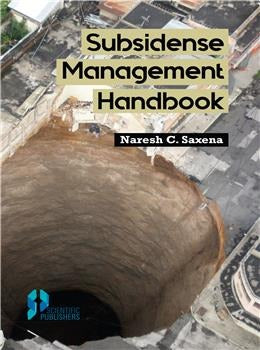Subsidence Management Handbook
Subsidence Management Handbook is backordered and will ship as soon as it is back in stock.
Couldn't load pickup availability
Genuine Products Guarantee
Genuine Products Guarantee
We guarantee 100% genuine products, and if proven otherwise, we will compensate you with 10 times the product's cost.
Delivery and Shipping
Delivery and Shipping
Products are generally ready for dispatch within 1 day and typically reach you in 3 to 5 days.
Book Details
-
Author: N.C. Saxena
-
Publisher: Scientific Publishers
-
Language: English
-
Edition: 1st Edition, 2018
-
ISBN: 9788172333171
-
Binding: Hard Bound
-
Pages: 205
-
Size: 5.70 x 8.70 x 1.5 inches
-
Weight: 390 grams
-
Book Type: Reference Book
About the Book
This book focuses on the topic of subsidence movements, particularly those caused by underground mining and groundwater withdrawal. Subsidence movements, both natural and manmade, have gained increasing attention due to their impacts on the surface, subsurface, and underground properties, which can affect the environment, infrastructure, and human life.
The author, N.C. Saxena, addresses the significance of subsidence caused by underground mining in sedimentary deposits and the withdrawal of groundwater, especially in the Indian context. These activities have been ongoing for decades, but there has been a lack of comprehensive, indigenous literature on the subject for mining operators, students, and planners.
Key Features:
-
Understanding Subsidence Movements:
The book explores the causes, impacts, and prediction of subsidence movements, particularly in the context of underground mining and groundwater extraction. The author provides simple, effective guidelines for managing subsidence and mitigating its impacts. -
Focus on Indian Context:
The author emphasizes Indian-specific scenarios, particularly the effects of mining in sedimentary deposits and the long-standing issue of groundwater withdrawal in India. This book aims to fill the gap in literature for mining operators, students, and planners by offering localized solutions for subsidence management. -
Two and Three-Dimensional Predictions:
The book presents two-dimensional and three-dimensional predictions of subsidence movements, supported by real-world examples. These predictions help understand the potential impacts of subsidence on the surface and underground properties, which is essential for mining safety and environmental clearance. -
Case Studies:
The book includes five case studies related to coal mining subsidence, providing valuable insights into the management of subsidence in mining operations. These case studies highlight real-life challenges and solutions for subsidence prediction, impact mitigation, and land management. -
Management Techniques:
It covers subsidence management techniques, including optimization, land management after subsidence, and converting subsided land into resources. The book provides practical knowledge on how to mitigate the adverse effects of subsidence, making it highly relevant for professionals in the field. -
Groundwater Withdrawal Subsidence:
The author discusses subsidence caused by groundwater withdrawal, detailing the phenomenon, affecting factors, impacts, and strategies for land subsidence management. This section emphasizes the importance of addressing groundwater-related subsidence before it becomes a major problem in India.





